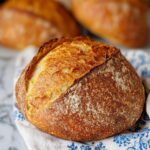Description
This classic Sourdough Bread recipe yields a crusty and flavorful loaf made with a natural sourdough starter. Featuring a blend of bread and rye flours, the dough undergoes a slow fermentation process including stretch and folds, bench resting, and cold proofing for optimal texture and taste. Baked in a preheated Dutch oven at high heat, this bread boasts a crisp crust and chewy crumb perfect for sandwiches, toasting, or enjoying fresh with butter.
Ingredients
Scale
Flours
- 400 g bread flour (or all-purpose flour, plus more to dust)
- 55 g rye flour (or whole wheat or bread flour)
- Rice flour (optional, for dusting the bread basket)
Other Ingredients
- 10 g fine sea salt
- 345 g filtered water (or dechlorinated/spring water, lukewarm up to 85˚F)
- 100 g active sourdough starter
Instructions
- Feed the Starter: Feed your sourdough starter 1 or 2 times before making the bread to ensure it is active. Mix 50g starter with 50g bread flour and 50g lukewarm water. Cover loosely and let rise at room temperature until doubled in size, about 4-6 hours.
- Make the Dough: In a large bowl, whisk together bread flour, rye flour, and salt. Add water and sourdough starter. Stir with a wooden spoon then mix thoroughly by hand, pinching the dough to combine well. The dough will be sticky. Scrape down bowl, cover with a towel, and let rest at room temperature for 4 hours.
- Bulk Fermentation Stretch and Fold: Every hour during the 4-hour bulk fermentation, perform a round of stretch and folds. With wet hands, gently lift and stretch one side of the dough upwards without tearing, then fold it over itself. Rotate the bowl quarter turn and repeat about 3 more times until the dough resists pulling. Keep covered between rounds. After the final (fourth) fold, let it rest.
- Shape the Loaf: Turn dough onto a lightly floured surface. If doubled for 2 loaves, cut in half. Gently stretch and shape dough to fit your banneton (bread basket) or baking pot.
- Bench Rest: Place dough seam-side down, cover with a towel, and let rest for 20 minutes to relax and slightly proof.
- Tighten the Dough: If the dough loosens during bench rest, gently reshape to tighten. Cup hands around dough edges, tuck the sides underneath, and pull the dough down the counter in a circular motion to create tension.
- Cold Fermentation: Transfer dough seam-side up into a banneton dusted with rice flour. Cover with a tea towel and refrigerate for at least 8 hours up to 48 hours to develop flavor and improve texture.
- Preheat the Oven: Place a Dutch oven or combo cooker (and optionally a pizza stone on the bottom rack) in the oven and preheat to 500°F at least 30 minutes before baking.
- Score the Bread: Turn the dough out onto parchment paper or a bread sling. Using a bread lame, score a 1/3 to 1/2 inch deep crescent shape around the top of the bread at a 45-degree angle starting at the base on one side. Transfer dough with parchment into the Dutch oven if using.
- Bake: Cover with the preheated lid and place into the oven. Immediately reduce oven temperature to 450°F. Bake covered for 20 minutes, then remove the lid and bake uncovered for an additional 20-25 minutes until the crust is deeply golden and desired color.
Notes
- Use filtered, dechlorinated, or spring water warmed to about 85˚F to encourage fermentation.
- Rye flour can be substituted with whole wheat or all bread flour if unavailable.
- Rice flour is ideal for dusting bannetons to prevent sticking without adding moisture.
- Bannetons can be replaced with a well-floured bowl if needed.
- Cold fermentation enhances flavor and texture; do not skip this resting step.
- Ensure oven and Dutch oven are fully preheated to achieve a good oven spring and crust.
- Handle dough gently to preserve air bubbles for a better crumb structure.
- Scoring controls oven expansion and adds decorative aesthetic.

